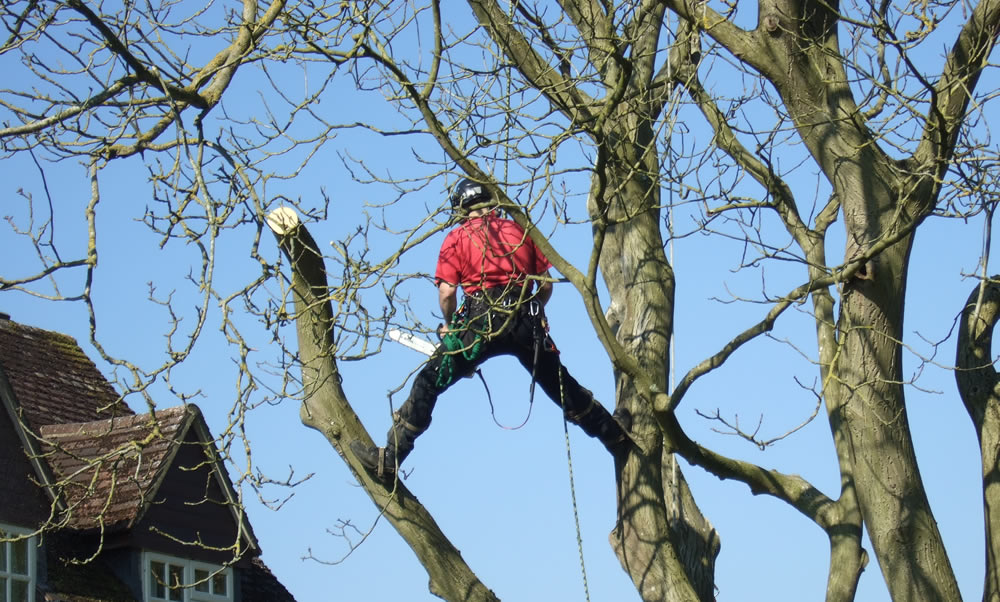The following services we offer are designed to improve and preserve the crown of the tree without having a detrimental affect on the tree, whilst also improving the aesthetics and hopefully resulting in excellent customer satisfaction as well as value for money.
We can offer many forms of Tree Pruning, whether it is reducing a large tree or reshaping, removing dangerous branches or thinning out the tree. Some of the following terms/methods of tree pruning are used when people talk about having their trees pruned:
Crown Thinning
Crown thinning is the removal of a portion of smaller/tertiary branches, usually at the outer crown, to produce a uniform density of foliage around an evenly spaced branch structure. It is usually confined to broad-leaved species. Crown thinning does not alter the overall size or shape of the tree. Material should be removed systematically throughout the tree, should not exceed the stated percentage and not more than 30% overall. Common reasons for crown thinning are to allow more light to pass through the tree, reduce wind resistance, reduce weight (but this does not necessarily reduce leverage on the structure), and is rarely a once-only operation particularly on species that are known to produce large amounts of epicormic growth.
Crown Lift or Crown Raising
Crown lifting is the removal of the lowest branches and/or preparing of lower branches for future removal. Good practice dictates crown lifting should not normally include the removal of large branches growing directly from the trunk as this can cause large wounds which can become extensively decayed leading to further long-term problems or more short term biomechanical instability. Crown lifting on older, mature trees should be avoided or restricted to secondary branches or shortening of primary branches rather than the whole removal wherever possible. Crown lifting is an effective method of increasing light transmission to areas closer to the tree or to enable access under the crown but should be restricted to less than 15% of the live crown height and leave the crown at least two-thirds of the total height of the tree. Crown lifting should be specified with reference to a fixed point, e.g. ‘crown lift to give 5.5m clearance above ground level’.
Crown Reduction
The reduction in height and/or spread of the crown (the foliage bearing portions) of a tree. Crown reduction may be used to reduce mechanical stress on individual branches or the whole tree, make the tree more suited to its immediate environment or to reduce the effects of shading and light loss, etc. The final result should retain the main framework of the crown, and so a significant proportion of the leaf-bearing structure, and leave a similar, although smaller outline, and not necessarily achieve symmetry for its own sake. Crown reduction cuts should be as small as possible and in general not exceed 100mm diameter unless there is an overriding need to do so. Reductions should be specified by actual measurements, where possible, and reflect the finished result, but may also refer to lengths of parts to be removed to aid clarity, e.g. ‘crown reduce in height by 2.0m and lateral spread by 1.0m, all round, to finished crown dimensions of 18m in height by 11m in spread (all measurements approximate.)’. Not all species are suitable for this treatment and crown reduction should not be confused with ‘topping’, an indiscriminate and harmful treatment.
Pollarding and Re-pollarding
The initial removal of the top of a young tree at a prescribed height to encourage multistem branching and dense new growth from that point, traditionally for fodder, firewood or poles. Once started, it should be repeated on a cyclical basis always retaining the initial pollard point, or bolling as it becomes known. This technique is used on avenues of trees.
Formative Pruning
Minor pruning during the early years of a tree’s growth to establish the desired form and/or to correct defects or weaknesses that may affect the structure in later life.
Coppicing
The cutting down of a tree within 300mm (12in) of the ground at regular intervals, traditionally applied to certain species such as Hazel and Sweet Chestnut to provide stakes etc.
We offer a professional service, clients’ wishes are listened to and a solution to the well-being of the tree is an end result. We leave all sites tidy and can remove all debris.
We carry out our tree pruning services in Oxfordshire, Northamptonshire, Buckinghamshire, and we are a member of the Arboricultural Association. We are approved by Trading Standards and a member of Buy with Confidence.

